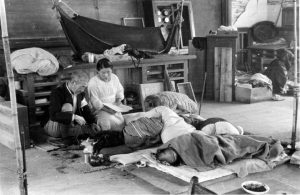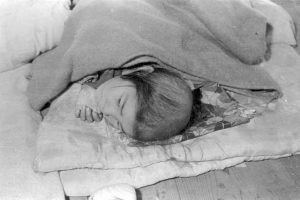Documenting Hiroshima of 1945: October 11–13, prayers for recovery of mother and daughter included in daily filming log
Oct. 13, 2024
by Kyosuke Mizukawa, Senior Staff Writer
During the period October 11–13, Masao Yamanaka, a medical team member of the film production company Nippon Eigasha (Nichiei), visited a relief hospital that had been set up in Oshiba National School (now Oshiba Elementary School in Hiroshima City’s present-day Nishi Ward). On October 11, the day Mr. Yamanaka was looking for potential filming sites, he openly described the feelings that arose in him at the hospital in a daily filming log.
“Comparing her to my own child, I was overwhelmed with pity. Curse America. Before leaving for home, I prayed to God to save the lives of the child and her mother.”
Yoko Takeuchi, a 12-year-old patient at the hospital stirred those feelings of pity in Mr. Yamanaka, who was 42 at the time. Ms. Takeuchi had been trapped under a refrigerator that had fallen at her house in the area of Funairi-machi (in Hiroshima’s present-day Naka Ward) at the time of the bombing, suffering such serious injuries to her legs that even the bones were visible. She also had suffered hair loss.
At first, her mother, Yoneko Takeuchi, 31 at the time, took care of her daughter, because she had also experienced the bombing at their home but suffered seemingly no injuries. But, her mother had begun to exhibit spots over her body and suffered bleeding from her gums. Both were admitted to the hospital.
On October 12, Nichiei’s medical team filmed the mother and daughter lying on the floor of the destroyed school building. Mr. Yamanaka wrote in his log in an entry dated October 12, “After asking, I was told the mother would only be alive for several more days.” In an entry dated October 13, he wrote that when he gave Yoko candy that same day, “She was very pleased.” However, the mother died on October 14, and the daughter passed away on November 3.
Scenes of the mother and daughter were also captured in photographs taken by Shunkichi Kikuchi, who was accompanying the film crew. In his personal account in a collection titled Genbaku wo Totta Otoko-tachi (in English, ‘Men who photographed the atomic bombing’), published in 1987, Mr. Kikuchi wrote, “I felt that the cruelty and the reality of the atomic bombing had been revealed to me … I took their photo with a sense of guilt.”
Lasting from October through December, the “third phase” of acute radiation effects from the atomic bombing of Hiroshima is considered to have been marked by the improvement of symptoms. However, recovery did not come to everyone equally, and the death toll continued to rise. Mr. Yamanaka expressed his concerns in a log entry dated October 12. “We still do not exactly know how many more patients exist. Even with Japan losing the war, we have to wonder what the government is thinking about relief measures for such patients,” he wrote.
(Originally published on October 13, 2024)
During the period October 11–13, Masao Yamanaka, a medical team member of the film production company Nippon Eigasha (Nichiei), visited a relief hospital that had been set up in Oshiba National School (now Oshiba Elementary School in Hiroshima City’s present-day Nishi Ward). On October 11, the day Mr. Yamanaka was looking for potential filming sites, he openly described the feelings that arose in him at the hospital in a daily filming log.
“Comparing her to my own child, I was overwhelmed with pity. Curse America. Before leaving for home, I prayed to God to save the lives of the child and her mother.”
Yoko Takeuchi, a 12-year-old patient at the hospital stirred those feelings of pity in Mr. Yamanaka, who was 42 at the time. Ms. Takeuchi had been trapped under a refrigerator that had fallen at her house in the area of Funairi-machi (in Hiroshima’s present-day Naka Ward) at the time of the bombing, suffering such serious injuries to her legs that even the bones were visible. She also had suffered hair loss.
At first, her mother, Yoneko Takeuchi, 31 at the time, took care of her daughter, because she had also experienced the bombing at their home but suffered seemingly no injuries. But, her mother had begun to exhibit spots over her body and suffered bleeding from her gums. Both were admitted to the hospital.
On October 12, Nichiei’s medical team filmed the mother and daughter lying on the floor of the destroyed school building. Mr. Yamanaka wrote in his log in an entry dated October 12, “After asking, I was told the mother would only be alive for several more days.” In an entry dated October 13, he wrote that when he gave Yoko candy that same day, “She was very pleased.” However, the mother died on October 14, and the daughter passed away on November 3.
Scenes of the mother and daughter were also captured in photographs taken by Shunkichi Kikuchi, who was accompanying the film crew. In his personal account in a collection titled Genbaku wo Totta Otoko-tachi (in English, ‘Men who photographed the atomic bombing’), published in 1987, Mr. Kikuchi wrote, “I felt that the cruelty and the reality of the atomic bombing had been revealed to me … I took their photo with a sense of guilt.”
Lasting from October through December, the “third phase” of acute radiation effects from the atomic bombing of Hiroshima is considered to have been marked by the improvement of symptoms. However, recovery did not come to everyone equally, and the death toll continued to rise. Mr. Yamanaka expressed his concerns in a log entry dated October 12. “We still do not exactly know how many more patients exist. Even with Japan losing the war, we have to wonder what the government is thinking about relief measures for such patients,” he wrote.
(Originally published on October 13, 2024)









